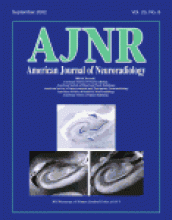To the Editor: We read with interest the case report by Blanc et al (1) concerning delayed stroke secondary to increasing mass effect exerted by a giant carotid aneurysm on the middle cerebral artery after treatment by parent vessel occlusion. We disagree, however, with the conclusion that the delayed ischemic event was due to swelling of the thrombosed aneurysm with further compression to the left middle cerebral artery. This conclusion is not supported by the evidence presented, namely the diagnostic angiogram (Fig 1B), the angiogram obtained immediately after treatment (Fig 2), and the angiogram obtained 8 days after treatment (Fig 3).
Figures 2 and 3 are practically identical in magnification and are very similar, although not absolutely identical, in projection. If a reference line is drawn between two fixed points visible on Figures 2 and 3, namely the right middle cerebral artery bifurcation and a left middle cerebral artery branch lateral to the insula, and the maximum elevation of the left M1 segment above this line is measured, it is clear that the elevation is no greater in Figure 3 than in Figure 2. There is thus no objective evidence of an increase in the aneurysm size. There is undoubtedly evidence of narrowing of the M1 segment and some M2 branches; however, we think that the explanation for this is not further compression. Figure 2 shows considerable elevation with only slight narrowing. Why should a further degree of elevation, so small that it cannot be measured even if it were present, cause the marked narrowing seen in Figure 3? Moreover, comparison between Figures 1B and 3 shows that narrowing in Figure 3 is seen in M2 branches too far lateral to be compressed by the aneurysm.
The middle cerebral artery narrowing seen in this case is a very interesting and important observation. The evidence presented, however, does not support the thesis that the marked narrowing seen in the middle cerebral arteries after parent vessel occlusion was caused by aneurysm swelling. Explanation of the narrowing should be sought elsewhere and is possibly the release of vasoactive factors, which is also mentioned.
References
- Copyright © American Society of Neuroradiology












